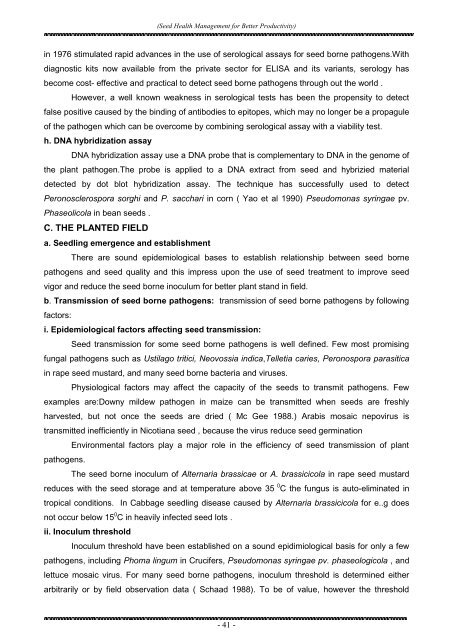Seed Health Management for Better Productivity - Govind Ballabh ...
Seed Health Management for Better Productivity - Govind Ballabh ...
Seed Health Management for Better Productivity - Govind Ballabh ...
Create successful ePaper yourself
Turn your PDF publications into a flip-book with our unique Google optimized e-Paper software.
(<strong>Seed</strong> <strong>Health</strong> <strong>Management</strong> <strong>for</strong> <strong>Better</strong> <strong>Productivity</strong>)in 1976 stimulated rapid advances in the use of serological assays <strong>for</strong> seed borne pathogens.Withdiagnostic kits now available from the private sector <strong>for</strong> ELISA and its variants, serology hasbecome cost- effective and practical to detect seed borne pathogens through out the world .However, a well known weakness in serological tests has been the propensity to detectfalse positive caused by the binding of antibodies to epitopes, which may no longer be a propaguleof the pathogen which can be overcome by combining serological assay with a viability test.h. DNA hybridization assayDNA hybridization assay use a DNA probe that is complementary to DNA in the genome ofthe plant pathogen.The probe is applied to a DNA extract from seed and hybrizied materialdetected by dot blot hybridization assay. The technique has successfully used to detectPeronosclerospora sorghi and P. sacchari in corn ( Yao et al 1990) Pseudomonas syringae pv.Phaseolicola in bean seeds .C. THE PLANTED FIELDa. <strong>Seed</strong>ling emergence and establishmentThere are sound epidemiological bases to establish relationship between seed bornepathogens and seed quality and this impress upon the use of seed treatment to improve seedvigor and reduce the seed borne inoculum <strong>for</strong> better plant stand in field.b. Transmission of seed borne pathogens: transmission of seed borne pathogens by followingfactors:i. Epidemiological factors affecting seed transmission:<strong>Seed</strong> transmission <strong>for</strong> some seed borne pathogens is well defined. Few most promisingfungal pathogens such as Ustilago tritici, Neovossia indica,Telletia caries, Peronospora parasiticain rape seed mustard, and many seed borne bacteria and viruses.Physiological factors may affect the capacity of the seeds to transmit pathogens. Fewexamples are:Downy mildew pathogen in maize can be transmitted when seeds are freshlyharvested, but not once the seeds are dried ( Mc Gee 1988.) Arabis mosaic nepovirus istransmitted inefficiently in Nicotiana seed , because the virus reduce seed germinationEnvironmental factors play a major role in the efficiency of seed transmission of plantpathogens.The seed borne inoculum of Alternaria brassicae or A. brassicicola in rape seed mustardreduces with the seed storage and at temperature above 35 0 C the fungus is auto-eliminated intropical conditions. In Cabbage seedling disease caused by Alternaria brassicicola <strong>for</strong> e..g doesnot occur below 15 0 C in heavily infected seed lots .ii. Inoculum thresholdInoculum threshold have been established on a sound epidimiological basis <strong>for</strong> only a fewpathogens, including Phoma lingum in Crucifers, Pseudomonas syringae pv. phaseologicola , andlettuce mosaic virus. For many seed borne pathogens, inoculum threshold is determined eitherarbitrarily or by field observation data ( Schaad 1988). To be of value, however the threshold- 41 -
















